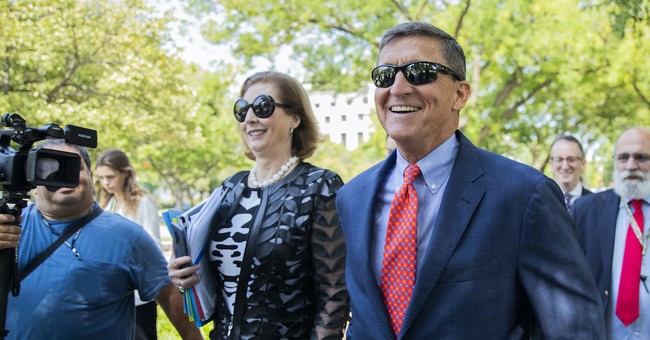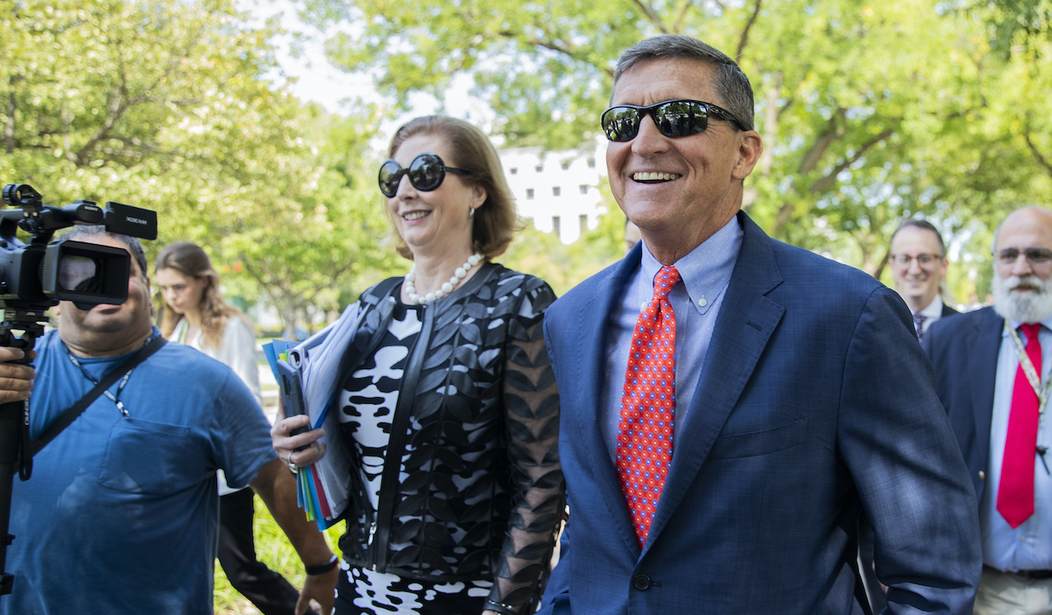
The Department of Justice filed an Appellate Brief in support of the Petition for Writ of Mandamus filed by General Flynn on the same day that Judge Sullivan filed his response to the Circuit Court’s order that he do so.
I’m going to break the DOJ brief down into three parts, and write separately as to each, because I think it will be better understood in that fashion – and simpler for me to break down for non-lawyers interested in understanding the arguments advance by the Justice Department lawyers.
But before I start on the DOJ brief, I don’t want to repeat an earlier mistake and assume all who are reading this are fully informed on how we got to this point in the case. So I’ll start with a “brief” primer on the case so far, and a short introduction into a key issue raised by the Government brief.
In the August 2016, the FBI opened a sub-file investigation of General Michael Flynn under the umbrella of the Crossfire Hurricane investigation into connections between the Trump campaign and Russian government actors. After more than four months, the Case Agent for the Flynn sub-file was prepared to close the investigation, having found “no derogatory information” that supported the factual basis – the “predication” — upon which the investigation was opened. But then the calls between Gen. Flynn and Russian Ambassador Kislyak became known to the FBI, and a decision was made to send two FBI Agents to interview Gen. Flynn on Jan. 24, 2017. The questions asked and answers given during that interview are the basis for what later became a prosecution of Gen. Flynn for having made false statements to the FBI Agents during the interview.
But the prosecution of Gen. Flynn does not seem to have been initiated until after the appointment of Robert Mueller as Special Counsel. Jim Comey, while he was still leading the FBI, said he did not believe Gen. Flynn would face any legal consequences connected to the interview. Comey knew everything Flynn had said when he made that statement, and Flynn had been terminated in a very public fashion over claims that he was not truthful with other members of the Administration.
So far as has ever been reported, the FBI never “referred” the Flynn investigation to DOJ for prosecution. To the best of my knowledge, the first indication of a criminal prosecution of Gen. Flynn that has been reported was the August 2, 2017, “Scope Memo” issued by Rod Rosenstein to the Special Counsel. That Scope Memo expressly authorized the Special Counsel to determine whether Gen. Flynn “committed a crime or crimes by making false statements to the FBI when interviewed about his contacts with the Russian government”.
On December 1, 2017, General Flynn pled guilty to one count of making false statements to the FBI during the January 24, 2017 interview.
So in less than four months, the Special Counsel obtained a guilty plea from Gen. Flynn. And we now know it accomplished this task without doing any of the following:
- Providing Gen. Flynn’s lawyers with a recording or transcript of his call with Amb. Kislyak.
- Providing Gen. Flynn’s lawyers with the approved and filed copy of the Form 302 Memo of Interview completed by the interviewing agents.
- Advising Gen. Flynn that the interviewing Agents did not believe he had intentionally misled them with his answers to their questions.
- Disclosing any factual details about how Gen. Flynn’s answers during the interview had the potential to mislead or impede the FBI investigation such that the would be legally “material” under the alleged crime of making false representations.
This list could continue with several more entries. But the point is well made – in four months the Special Counsel was able to ram a plea deal down Gen. Flynn’s throat by threatening prosecution of his son, and by promising him a term of probation as a sentence – all he had to do was agree to cooperate and provide information about Pres. Trump and the Trump campaign.
After more than a year of post-plea litigation following the entry of new counsel into the case on behalf of Gen. Flynn, and facing the filing deadline to respond to Gen. Flynn’s motion to withdraw his guilty plea based in part on government misconduct, and in part of ineffective assistance of counsel (in which the government might have played a role), the Department of Justice instead filed a motion to dismiss the case against Gen. Flynn.
Because Judge Emmet Sullivan has repeatedly expressed hostility towards Gen. Flynn and his defense team, instead of granting the unopposed motion that included specific factual details about why dismissal is appropriate under the facts of this case, Judge Sullivan instead created a process by which he intended to render a judgment not just on Gen. Flynn, but also on the propriety of the action undertaken by DOJ now that the Special Counsel’s Office is no more.
Gen. Flynn’s counsel responded with a Petition filed in the Circuit Court of Appeals asking that Court to direct Judge Sullivan to grant the dismissal, and not to conduct the inquiry he has set to take place. The Circuit Court responded to the Petition with a very surprising Order directing Judge Sullivan to respond to the claims made in the Petition. On the same day Judge Sullivan filed his response as ordered, the Department of Justice filed a brief in support of Gen. Flynn’s Petition.
My review of the DOJ brief will come in three parts.
This part will introduce the “Separation of Powers” arguments advanced by DOJ Brief.
Part 2 will look at those “Separation” arguments in more detail, taking into account the competing arguments raised by Gen. Flynn’s antagonists.
Part 3 will address the claims of error that DOJ raises regarding Judge Sullivan’s proposed course of action, and also make some predictions as to how the Circuit Court might address the dueling views of the two sides.
The first observation I have about the DOJ Brief is that its noteworthy that the Brief is the product of the Solicitor General’s Office, and not the U.S. Attorney for the District of Columbia. It is filed under the names of both but the work-product is clearly that of the SG’s Office, which as a general matter handles only briefing and oral argument before the Supreme Court. For appellate work on behalf of the United States, the Solicitor General’s Office is where the “best and brightest” hang out.
The Separation of Powers claims are right in the “wheelhouse” of the SG, as this is the kind of argument that often creates and resolves issues before the Supreme Court as they involve competing “visions” and tensions among the three branches of government about how they go about working with one another.
The Brief first addresses the question as to why there is “urgency” to cutoff Judge Sullivan from pursuing his intended course of conduct. Why not allow this matter to be dealt with in the ordinary course – allowing Judge Sullivan to conduct proceedings he deems necessary, issue a ruling based on his findings, and then allow any party who disagrees with his ruling to challenge that ruling in the normal appeals process.
The Brief responds to this question by advancing the idea that moving expeditiously by way of a Writ avoids “an unwarranted impairment” by Judge Sullivan of the Executive Branch’s “performance of its constitutional duties.”
At its core what this argument advances is the idea that when the Executive Branch, while executing its constitutional duties to see that that the laws are faithfully executed and enforced, comes across information establishing that an ongoing enforcement action is mistaken or amounts to an injustice, the Executive must move with all due haste to bring the enforcement action to an end.
The Justice Department has taken a position in a legal filing with the Judicial branch that it is no longer convinced that Gen. Flynn committed a crime, and it is certain that it would not be able to prove any such crime beyond a reasonable doubt if it attempted to do so in a trial.
Yet based on Justice Department conduct up to the date of that determination, Gen. Flynn remains a defendant in a criminal case pending in United States District Court. As such, the Justice Department has an ethical obligation – and an obligation under its own internal policies (explained later) – to move without delay to bring an end to that pending matter.
What Judge Sullivan proposes to do is an “unwarranted impairment” of the Executive Branch’s effort to fulfill its constitutional obligations to Gen. Flynn. The Justice Department has filed a motion that is within the scope of its authority. Where the contents of that motion address the necessary legal standards that the Justice Department must follow in taking the action contemplated by the motion, there is no basis for the Judicial branch to “look behind” the motion for some ulterior motivation.
The course of action proposed by Judge Sullivan is unwarranted in terms of the substance, that the process he proposes to follow is an interference with Executive branch functions in violation of the Separation of Powers doctrine.
Coming tomorrow: Part 2 covering the DOJ Separation of Powers claims in more detail.















Join the conversation as a VIP Member